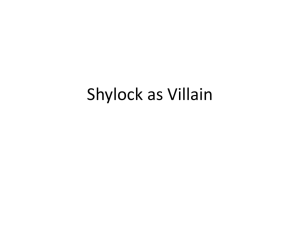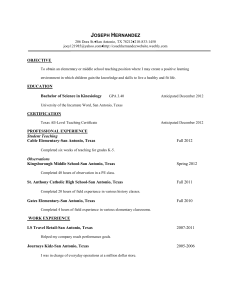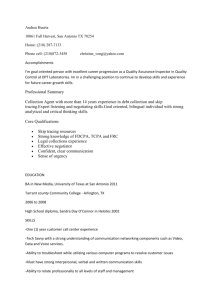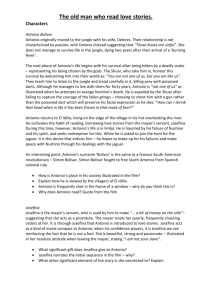The Old Man Who Read Love Stories
advertisement
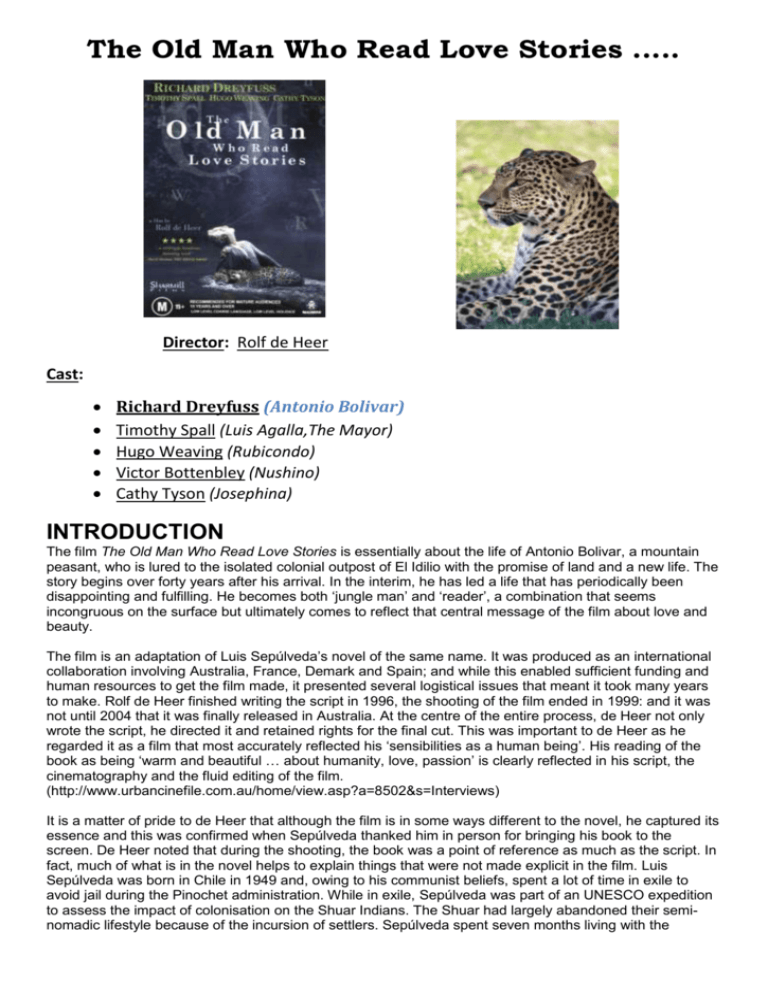
The Old Man Who Read Love Stories ..... Director: Rolf de Heer Cast: Richard Dreyfuss (Antonio Bolivar) Timothy Spall (Luis Agalla,The Mayor) Hugo Weaving (Rubicondo) Victor Bottenbley (Nushino) Cathy Tyson (Josephina) INTRODUCTION The film The Old Man Who Read Love Stories is essentially about the life of Antonio Bolivar, a mountain peasant, who is lured to the isolated colonial outpost of El Idilio with the promise of land and a new life. The story begins over forty years after his arrival. In the interim, he has led a life that has periodically been disappointing and fulfilling. He becomes both ‘jungle man’ and ‘reader’, a combination that seems incongruous on the surface but ultimately comes to reflect that central message of the film about love and beauty. The film is an adaptation of Luis Sepúlveda’s novel of the same name. It was produced as an international collaboration involving Australia, France, Demark and Spain; and while this enabled sufficient funding and human resources to get the film made, it presented several logistical issues that meant it took many years to make. Rolf de Heer finished writing the script in 1996, the shooting of the film ended in 1999: and it was not until 2004 that it was finally released in Australia. At the centre of the entire process, de Heer not only wrote the script, he directed it and retained rights for the final cut. This was important to de Heer as he regarded it as a film that most accurately reflected his ‘sensibilities as a human being’. His reading of the book as being ‘warm and beautiful … about humanity, love, passion’ is clearly reflected in his script, the cinematography and the fluid editing of the film. (http://www.urbancinefile.com.au/home/view.asp?a=8502&s=Interviews) It is a matter of pride to de Heer that although the film is in some ways different to the novel, he captured its essence and this was confirmed when Sepúlveda thanked him in person for bringing his book to the screen. De Heer noted that during the shooting, the book was a point of reference as much as the script. In fact, much of what is in the novel helps to explain things that were not made explicit in the film. Luis Sepúlveda was born in Chile in 1949 and, owing to his communist beliefs, spent a lot of time in exile to avoid jail during the Pinochet administration. While in exile, Sepúlveda was part of an UNESCO expedition to assess the impact of colonisation on the Shuar Indians. The Shuar had largely abandoned their seminomadic lifestyle because of the incursion of settlers. Sepúlveda spent seven months living with the Shuar; a time he described as ‘enormously important’ as it changed his whole outlook on life and what it was to be South American. In particular, he became attuned to the ‘close relationship of dependence and protectiveness with nature’ and became concerned about the political struggle of ‘rediscovering ecological dignity’ (Bernard, 2010). This concern is clearly reflected in the film. It was shot entirely on site in the jungle of French Guiana and its beauty is eloquently captured by the cinematography and contrasts with the negative depiction of the colonialists. The story itself can be classified as a fairy tale, parable and/or fantasy story, as it is written in the magic realism tradition of South American literature. It might also be called an adventure story. There is a hero who is faced with a trial and great enemy (in this case the hunt for the jaguar) and vanquishes it to win the girl. He is accompanied by his sidekicks who help to counteract the influence of the evil, and corrupt nemesis, the Mayor. The characters are clearly delineated to show respect for the indigenous tribe and condemnation for the colonialists. The Shuar are depicted as walking through the jungle upright with dignity, their skin unblemished and clean, their loincloths a pure, bold red. They are at one with the jungle and treat it and its inhabitants with respect — even their prey and foes. There is something just and democratic about their attitude. In contrast, the colonial government is corrupt despite claiming to be a product of democracy. The local Mayor is elected through bribes of alcohol to an indifferent constituency who dub him ‘Slimy Toad’ in recognition of his brash, manipulative ways. The original intention of settling in this area of the world was to farm the land, yet it is only implicit in the film that this fails because the jungle resists all attempts to do so — farmland being swallowed up by the jungle almost as quickly as it is cleared. Yet the colony is persistent in its attempts to impose Western culture on the land and in the place of farmers come the ‘gringo’ prospectors. In contrast to the Shuar, their clothing is mostly dirt stained and their faces stubbled. Their alcohol swilling combines with their abrasive and violent attitudes to indicate a discontent they seem oblivious to. Despite all of their airs of superiority to the ‘savages’, their physical and moral corruption is a blight on the beautiful landscape they have invaded and an indictment of colonialism in general. De Heer is renowned for making films about characters on the fringe of society and this is no exception. Our hero stands between the polarised cultures. In living with the indigenous tribe in the jungle, he has learnt the kind of respect for it that his fellow citizens lack. Yet at the start of the film he has been banished because he fails the mission of avenging the death of his friend, Nushino. While he is ‘like’ the Shuar, he is not one of them and on his return to El Idilio, he is not one of the townspeople either. Having left the jungle he is in need of something to fill in time and escape the ‘brutality of man’. He discovers that he has the ‘antidote to the poison of old age … he could read’. What he chooses to read is love stories because they contain beautiful words and thoughts. In reading about love, he falls in love. Meanwhile, the loud and brazen behaviour of the ‘gringos' disturbs the serenity of the jungle and their violence invites the ire of the jaguar. Antonio is coerced into hunting it to protect the colony but, through the many flashbacks that intersperse the hunt, we see his mind is preoccupied with his past — his failing of Nushino and his growing love of reading and Josefina. By the time the bumbling and cowardly Mayor finally leaves him alone to hunt the jaguar, we have seen enough of his past to understand that despite his human failings, he has an essential goodness that perhaps he doesn’t even recognise in himself. Although it is dramatic, the hunt is less about the drama and tension and more about the trial it represents. To begin with, Antonio is ‘the white man’s hunter’ who carries fear and a gun. When he finally discovers that the jaguar’s purpose in not attacking is to put its mate out of its misery, he thinks the hunt is over. Yet it seems that, grieving for its lost family, the jaguar wants to face death in a duel rather than live a life of painful solitude. This becomes a chance for Antonio to prove to himself that he is capable of the humanity missing from those who come to take from the jungle and spread fear and pain: ‘the ‘gringo’ … the settlers … government … tourists’. In the end, as you would expect in a fantasy/adventure/love story, he — the good guy — slays the beast, wins the girl and lives happily ever after. A PERSPECTIVE ON THE TEXT The Old Man Who Read Love Stories was quite well received by critics upon release but, despite being well constructed and visually beautiful, it experienced nowhere near the box office success of many Australian films, or even other films made by Rolf de Heer. Perhaps this is in part due to the fact that it is not iconically Australian or about Australians. Yet it is acutely relevant to the Australian context. Of central relevance is its environmental focus. Amazonian ecosystems are disappearing before Western society can learn anything about them. As the largest rainforest, the Amazon has been called the ‘world’s largest pharmacy’ for the natural medicines it provides and knowledge of the local medicines enable the Shuar to cure Antonio of the snakebite. It has also been called ‘the lungs of the world’ and with current concerns about global warming deforestation is an international concern — particularly for Australia as the world’s driest habitable continent. While Australians are frantically planting trees, they are being cleared at an alarming rate from the Amazon. While the film has no shots of logging or bleak panoramas of a cleared and scarred land, the settlement is a cog in the government machinery that is gradually destroying the Amazon. The white man’s forays into the jungle are representative of a larger picture of rape and pillage. The negative portrayal of the local government, settlers and prospectors is a condemnation of their presence in an environment where they clearly don’t belong. The Mayor wears his boots as a sign of civilisation but he trudges clumsily through the jungle, demonstrating how incongruous and inappropriate his presence is. Like the other ‘gringos’, he carries and fires his weapon with frightening randomness; death and destruction lay in their wake. The term ‘settler’ is ironic; the foreign presence of the white man upsets ‘the natural order of things’ and destroys the harmony of the jungle rather than settling things. The reason is ignorance that creates fear and Antonio and the Mayor act as foils to demonstrate this. While Antonio initially believes that the ‘lousy jungle fucked us all up’ the knowledge he acquires in living with the Shuar means that he can live in the jungle in peace and harmony, as is indicated through the flashbacks to his time with Nushino. Deliberately drawing attention to Antonio’s age in the title is an allusion to his wisdom and he is clearly respected by those around him. In the end, he understands that it is the ‘lousy “gringo”’ who ‘fucked us all up’. Conversely, because the Mayor and others are ignorant about the jungle and the animals that inhabit it, they act in ways that create greater danger. On a micro level, this is exemplified through the comic scene with the scorpion. On a macro level, it is seen through the killing of the jaguar’s family. While on completely different scales, these events are closely linked and indicate a central belief about the Amazon: that ‘when one attacks part of the rainforest, one is attacking a much larger whole’ (Gomides & Vogel, 2005). Of the many things in the jungle that might bring the white man undone, the jaguar is chosen for its beauty and strength as the unwilling champion of the natural environment. The anthropomorphic depiction of the jaguar is a means of garnering sympathy and support for its cause. It leads Antonio to its mate in order that it might be put out of the misery it has seemingly endured for days. When Antonio is able to end its suffering she still wails mournfully at her loss. The final way to ensure we side with the cat against the ‘gringos’ is by understanding she is committing revenge killings for the murder of her cubs. This also acts as a metaphoric suggestion that the next generation of the jungle is being destroyed, heralding more widespread loss and destruction. Beyond an immediate concern for the environment, there are wider implications in the loss of habitat. It is not only the negative effect that colonisation has had on the physical environment that is being criticised, but also the effect on indigenous people who rely on it for sustenance, physically and spiritually. This is something that should also resonate with an Australian audience given the increased awareness of the impact European colonisation has had on indigenous Australians. The ethnocentricity of white colonists saw them spread throughout Australia with similar attitudes to the Mayor, showing a complete disregard for the knowledge and sovereignty of the local inhabitants. The consequences that existed for Aboriginal Australians are reflected in the film either explicitly or implicitly: marginalisation, death and the destruction of culture. The effect of colonialism is not limited to environmental issues. Colonisation not only results in the loss of the indigenous ‘people, flora, and fauna of the Amazon but also man’s humanity’ (Gomides & Vogel, 2005). Having submersed himself in the milieu and culture of the Shuar, Antonio maintains some of his humanity and becomes ‘like’ them. However, he is not one of them and this is graphically represented in his killing of the ‘gringo’ and his failing of Nushino. Banished, Antonio not only needs to fill in time but the void that is created in his absence from the heart of the jungle. This void is filled by reading. Antonio rejects all the functional modes of reading because they remind him too much of the world he needs to escape from. His focus is on the aesthetic. While many might regard romance novels as trashy pulp, one cannot doubt that they are full of sentiment. They represent Antonio’s essential yearning for love, pure and unadulterated. His love of language and Josefina conflate with his love of the Shuar and their milieu and both have produced a serenity of spirit that allows his redemption at the end. The idea being postulated here is that being a bibliophile fosters biophilia. Our place in the modern world has become complex — possibly unnecessarily so. The old man’s message is a poignant yet very simple one: love and respect one another and the land around you that gives life; take time to appreciate beauty. In doing so one defeats ‘the barbarity of man’. Antonio’s initial failing of Nushino hints at the impossibility of acculturation as he cannot be one of the indigenous people and, therefore, should not be in the jungle at all. In Sepúlveda’s novel, Antonio shoots the cat with a gun before throwing his gun into the river in disgust that he is a part of a system that brings such violence and destruction to the jungle. The film has Antonio kill it with the traditional blowpipe. While this makes it less clearly a polemic on colonialism, his bitterness and grief at the death of the cat ensures Sepúlveda’s message about the need to rediscover ‘ecological dignity’ (Bernard, 2010). CHARACTERS Antonio Bolivar Why does the filmmaker have Antonio’s hut positioned outside the town? How does Antonio’s reaction to the butchery of the mule contrast with the others? What does it say about him that he takes the liver the Mayor offers him and cooks it? Why is Antonio frequently shot in the frame of a window? There are a number of shots with Antonio positioned on one side of the screen and a lot of space on the other side. Why has de Heer done this? When Antonio is being banished, what expressions are revealed by the many close-ups? What does he feel at this point of the film? Why doesn’t he give an explanation to Nushino? What is the effect of the tracking shot of Antonio in the canoe and the Shuar in the background? Josefina Why did the screenwriter use Josefina as the voiceover narrator? In Scene 14 Josefina gives Antonio the looking glass for the first time. What is the deeper meaning behind this? What does it offer Antonio? What is the significance of Josefina bringing it to Antonio in the hall so that he can take it on the hunt? In Scene 12 Antonio is closing the window shutters of the hut in preparation for staying the night. Why does a flashback show Josefina closing her shutters and turning to the camera? Why are Josefina and Antonio framed tightly together in most shots in the flashbacks to when they read together in Scene 13? The Mayor (Slimy Toad) List the ways disrespect is shown to the Mayor. Why does the Mayor position himself on the stage while addressing the men before the hunt? What is revealed about the Mayor when he shoots the mule and shouts, ‘We will see who can kill the best’? What does it say about the Mayor that he has someone holding an umbrella over him when he examines the body of Napoleon Salinas? What does his treatment of the body suggest? Why does the Mayor go on the hunt? Why does he leave it? When he discusses with Antonio ‘the deal’, he seems to be having a parallel conversation. What does this say about his assessment of human beings? What does this say about him as a reflection? Rubicundo (The Dentist) What does Rubicundo sacrifice to get Antonio his love stories? What does the way Rubicundo extract teeth suggest about him? Does his initial refusal to remove all of the teeth of the prospector contradict this in any way? Why does he suggest that a Bible will ‘rot’ Antonio’s brain? Nushino What cinematic devices are used to suggest that Nushino acts as Antonio’s conscience? How does Nushino’s death affect Antonio’s perception of himself? In the flashback to Nushino when the mule has been killed, why is Nushino framed with the rain behind him but not falling on him? Consider also the effect of lighting here. ISSUES AND THEMES Fear and Courage The Shuar shrink the heads of their adversaries after they have been killed so that they can capture their courage in the frozen expression. Courage is a key value for them and it is what the white man seems to lack most. This is most obvious in the Mayor. Despite all of his bluff and bluster and attempt to lead the way, he has no desire to face the jaguar, particularly on its own terms. In his fear, he foils the party in a number of ways, the most obvious of these being his random firing into the darkness from Alkaseltzer’s hut. His fear produces aggression and violence, and guns indicate violence at its most extreme. The younger Antonio learns a lot from the Shuar, but it seems that he’s not learned the crucial value of courage. When he confronts Nushino’s killer he misses with the blowpipe. While still on equal terms with him, he picks up the shotgun and kills him with the sort of violence that clearly shows no respect for life. Making terms more in his favour, he goes as far as to mentally disarm him in saying, ‘Don’t worry, they are not following you’ before he shoots him. To the Shuar, true courage is evident when you face an opponent on ‘equal’ terms and prove yourself the better of the two, based on your strength and ability. Hiding behind a gun requires no courage and this is something it takes Antonio a long time to truly realise. On the hunt Antonio cannot hide from his fear. The response to this fear is to take the gun into the jungle to kill the cat. He says of himself, ‘You are a white man’s hunter now. You carry a gun, you carry the fear’; but it seems he is willing to accept this negative assessment. When Rubicundo tells him that he should not face the jaguar on his own ground, Antonio replies, ‘It’s my ground, too’. There is an element of truth in this, but he does not confirm his true belonging by hunting with the blowpipe like the Shuar. His epiphany comes when he wounds the cat and remarks, ‘Now we are even’. There is no doubting the courage of the cat but there is reason to doubt Antonio’s and he understands that having a gun means that they are not ‘even’. The repeated flashbacks suggest that his failing of Nushino has haunted his memory. His choice to hunt as ‘one of’ them is his chance at redemption and the extent of the courage in his choice is evident by how close he comes to being killed himself. Having captured the courage of the cat he is able to move on with some piece of mind that he is less like the ‘gringos’ who created the mess to begin with. The courage Antonio finally displays is something Sepúlveda admired and there is veiled criticism of the settlers in his words below: ‘I need to come face to face with the elemental forces of nature, to prove to myself that I can survive on my own, relying on myself, and also to prove that the individual can live without being dependent.’ (Magnier, 2010) Love and Beauty These concepts are at times used interchangeably. While at first Antonio blames the death of his wife and their failure in starting a new life on the vagaries of the jungle, he ultimately realises that this is where beauty lies. Part of the problem he experienced as a settler is that he lived ‘outside’ the jungle and in ignorance of its workings, fighting it for his survival. The snakebite works as a metaphor for his relationship with the jungle. As a foreign resident living in ignorance he falls victim to its dangers. In being taken in by the Shuar, they use their knowledge to employ the naturally occurring medicines of the jungle to cure him. This is his initiation into the environment and the start of his understanding of how to live ‘with’ it. Flashbacks show him living for a long time in idyllic surroundings, existing on the bounty nature provides. As a person, he takes on the serenity of his environs.On being banished by the Shuar, he is no longer a part of a group that offers friendship and a sense of belonging. He loses that feeling of acceptance and love and, while he has been enriched in many ways, he is to some degree once again on the outside. He lives on the outskirts of the village and is again witness to the ‘barbarity of man’. Reading offers a replacement to satisfy his yearning for beauty. It is an escapist occupation and offers its own milieu. Engaged in the beauty of words and thoughts, there also is a sense of certainty in the genre and, despite the suffering, love and beauty always prevail. Reading becomes an act that enriches his soul. Josefina recognises Antonio’s essence, and through reading their inner beauty and love grows. This develops in him an attitude to his surrounds that, coupled with his need to atone for his past deeds, enables him to shed that part of his humanity that led to failing Nushino. The fairy tale ending has him cosily nestled in his hut basking in the beautiful love that has grown with Josefina. While it is a particularly Western picture of domestic bliss, he experiences the kind of fulfilment the Shuar must feel living ‘with’ their jungle environment. The question remains about whether there is any place for the white man in the Amazonian jungle, but it is clear that if any one is to live there, they need to develop respect for, and appreciation of, the beauty in the natural environment. The Barbarity of Man The film suggests that people have potential for both good and bad, and while some characters are more clearly good than others, all are in some way responsible for what can be seen as an act of barbarity. Even the Shuar, who live in the jungle in harmony with their surrounds, kill the sloth ‘for the sake of killing’. The two white characters who are regarded with sympathy, Antonio and Rubicundo, admit to seeing barbarity in themselves. Yet it is clearly most evident in the Mayor, the prospectors and the hunters. The Mayor represents state sanctioned brutality; most specifically, the brutality of colonisation. Ironically, he regards the indigenous inhabitants as ‘savages’. Yet his primary responsibility is to provide the administrative means for foreigners to scar and defile the jungle, looting it of its bounty. Far from being a settlement, El Idilio is an outpost that disturbs the serenity and ‘natural order’ of its surroundings. The ‘victims’ of the jaguar are victims of their own ignorance and brutality. The Mayor’s callous indifference to the life and death of others sees him unceremoniously dump the bodies into the river. That he is devoid of any notion of the sanctity of life is ironically portrayed through his cursory attempt at blessing the corpse of Napoleon Salinas, ending with, ‘something like that’. The brutality of the white man is not reserved for the natural environment and the indigenous population. The Mayor exploits and abuses Josefina, and manipulates others through bribes and coercion to ensure his position. His persistent shouting and abuse has a close association with the unsubtle explosion of dynamite and the sound of guns. However, perhaps the most graphic demonstration of brutality comes through the dentistry scenes. The pain and suffering experienced by the patient becomes a source of amusement for others. The scene where Rubicundo removes all of the teeth from a gold prospector has the men painted in a way that suggests a primal association where they are united by a common brutality. The source of this barbarity is the central motivation of the man: greed. The man has a bet with the others and his reward is the gold that they have taken from the jungle. It is the reason they have come to El Idilio and the pursuit of wealth will see them commit any act, however barbarous, even if it involves their own pain and destruction. For the prospectors, to bear pain shows courage. The clear contrast with the Shuar is that for them, courage means to kill without causing pain. Guilt and Redemption The difference between Antonio and other settlers is that he feels guilt for his acts of brutality. His failing of Nushino is an understandable mistake. As an outsider, he had an imperfect understanding of what was required in this act of revenge and he typically perceives the need for the taking ‘an eye for an eye’. Whether it is understandable or not makes no difference to Nushino who sees himself as eternally remaining a ‘blind parrot’ bumping around the jungle. This is the knowledge Antonio is apparently plagued by. Even though Antonio empathises with the jaguar, the hunt for it begins as an expedient necessity. However, his feelings of guilt are coupled with his developing understanding of love, and he finally sees that he has the chance to redeem himself in some way. Rather than being the ‘white man’s hunter’ he realises that if he is to be part of the jungle (or as the Shuar might say, live as ‘one of us’), he must live within its rules, and have the courage to meet his adversary on equal terms. In the end, he does not have to experience guilt at killing the cat, even though he mourns its death. He is able to curse ‘all the ‘gringos’ … the prospectors … settlers… government [and] tourists’ without hypocrisy and he has shown that he has a right to belong. LANGUAGE AND STYLE Settings: The Town/Buildings The name of the town is El Idilio, which is Spanish for ‘The Idyll’ or ‘The Romance’. The irony is that this is where the romantic illusions of Antonio and Delores of starting a new life together are crushed. Indeed, the town represents the opposite of romance. The dentist scenes are conducted on the wharf and the backdrop of the serene river is juxtaposed with the brutality of the dentistry to accentuate the complete absence of romance. The laughter of the onlookers, who regard the pain of the patient as entertainment, also poignantly indicates how lacking in sentiment they are. As a town it is the physical manifestation of Western ideology and lifestyle. The building of houses and the notion of ‘settling’ is accepted by white society as an integral sign of civilisation. Something that detracts from this assessment here is the fact that the buildings are grubby, poorly built and largely dilapidated — an indication that the suggestion of civilisation is a sham or poor facsimile; an idea reflected by the barbarous inhabitants of the buildings. The colony is an attempt to impose a ‘society’ onto a landscape where it isn’t suited; and this is underscored by the fact that there are many shots showing that while the town continues to exist, it is surrounded and dominated by the daunting jungle, which constantly threatens to overrun it. The Jungle The jungle is a place that, without the polluting influence of the ‘gringos’ is relatively free from corruption. The species that live in the jungle to some degree have to compete for survival so death is a natural part of life. The difference is that when a life is taken it is done so with respect, and the Shaur admire the courage of their adversaries and prey, hunting with them on equal terms. The jungle has a natural order and there is a degree of tranquillity and harmony for those who understand this. The beauty of its natural state is often conveyed through wide shots showing towering, awe inspiring trees (their height giving testament to their age and their rightful place as part of the landscape) as well as verdant, misted valleys. The dappled light in which many of the scenes are shot softens the harsh light of the other external shots. The many flashbacks show the enlightened Antonio with the Shuar existing comfortably in the jungle because they understand and respect it. Conversely, for the white men who don’t understand it, there lurk several dangers. This produces fear and aggression as a response. The white men bring corruption to the jungle through farming, prospecting and hunting for fur. They exploit and damage it and, metaphorically, the jungle fights back through its champion, the jaguar. Camera Work and Editing Rolf de Heer commented that the wanted this film to ‘flow like a river’ (http://www.urbancinefile.com.au/home/view.asp?a=8502&s=Interviews, 2010). He achieves this in a number of ways to create a gentleness and serenity in the film that undercuts the barbarous acts that also occur in it — thus ensuring that, at its heart, it is about love and beauty. The many tracking shots, particularly in the jungle, are integral in achieving this and convey a sense of fluidity. The many flashbacks are usually done with creative fades where two characters and/or points in time coexist in frame in a watermark fashion. The gentle transition from past to present in Antonio’s life makes it clear to the audience how integral to his present the events of the past are; it is clear that his memories are always with him, shaping his attitudes and actions. While the editing predominantly involves fades, abrupt cuts are used in times of tension to shock the audience. There is often violence associated with these cuts. Mise-en-scene is often important. There are a number of shots of Antonio where he occupies one side of the frame with ‘empty’ space to the side of him, creating a feeling of isolation. Why did the film open with a point of view shot travelling up the river to El Idilio and Antonio’s hut? What is the effect of having the camera track around the body of Nushino before focusing on Antonio in a long shot? Why is Antonio often shot from behind in partial light? What camera and editing techniques help to create tension when Antonio is tracking the jaguar? Sound and Music Much of the music has a Spanish flavour to it in keeping with the South American context, particularly in the reading and love scenes. It varies in tempo to complement the action, sometimes conjuring images of intensely passionate, colourful dancers. There are also times when tension is built through high-pitched violins combined with deep bass sounds, while at other times the angelic choral voices are uplifting. In jungle flashbacks when Antonio is with the Shuar, music occasionally features but these scenes mostly use diegetic sound. The sound of rain dominates at times but for the most part the sounds of the jungle are constant. This sound has subtle variations according to the mood of the scene. At night, eerie jungle noises often dominate from the darkness. At times of tension, the strident insect noises are somewhat louder and more disquieting. At other times bird sounds are more dominant and accentuate the natural beauty of the jungle. While the jungle sounds are not present in every scene, there is very little silence, and this generally occurs when the hunters are listening intensely for the jaguar in the dark. The seemingly ever-present sound of the jungle is a reminder of its latent power — that it is bigger and more powerful than the white man, despite his ability to destroy. Why is there no music during the dentistry scenes? Describe the music that is present in the flashbacks to Antonio reading with Josefina. What is the sound that dominates during the killing of the mule? What is the effect of this? When Antonio lets the jaguar float off in the river, what sound increasingly dominates? Why has this been done? The Structure The idea of reading is central to the film and this is accentuated through the structure of the script. The film begins and ends with the reading of a book. At the beginning it is a narrator reading the story of Antonio’s past life. This occurs mostly during the tracking shot that goes up the river to El Idilio where the present time story begins. The external shot of Antonio standing by himself at his window reading is similar to the final shot of the film. The crucial difference is that he is inside reading with Josefina. It is the same story they read, but the cosy feeling of them ensconced in the hut creates the ‘happy ever after’ feeling of a fairy tale. Also, at the beginning, as we later learn, Josefina is the narrator. At this stage she exists outside the story of Antonio’s life; the woman and love that is seemingly missing. At the end she, and the love she represents, are in the hut and his life is complete. While the narrative is basically linear, it is heavily interspersed with flashbacks that represent Antonio’s ‘inner life’. These are important in revealing formative past events. They broadly have two subjects: Antonio’s growing love for Josefina and his life with the Shuar. With the later, they increasingly reveal his ‘fall from grace’ in failing Nushino. The memories at the end culminate with the most intense feeling oflove for Josefina and the lowest ebb in his relationship with Nushino. By association, both are crucial in his decision to hunt the jaguar with integrity as a way to atone for his past failing and perhaps in some way for the grief and pain brought by the white man. Having relieved the jaguar of the ‘eternal misery’ it might endure after the loss of its family, there is a sense of redemption for his role in Nushino’s fate. Despite the bitter taste that is apparently left in his mouth, it enables him to move on and further away from the barbarity he was embroiled in. Why does the screenwriter choose to open the story with voiceover narration? Why does the narration end in the second scene? Consider when each flashback occurs. What prompts the flashback? How do they shape our perceptions of the present time events? Motifs The looking glass: an object that allows Antonio to read more easily. Literally it enables him to see better physically, but metaphorically he is able to access the love and sensitivity in the book; thus enabling him to see the world with deeper perspective. Guns: symbol of the violence and destruction of the white man, as well as of his fears. The blowpipe: silent and made from naturally occurring materials, it contrasts with the guns. Those who use it are living with the jungle and its creatures, hunting with courage and integrity. Love stories: being able to appreciate the beauty of the words and sentiments in these leads to a less barbaric worldview. Dentistry: the rotting teeth of the settlers, reflects their moral decay. The violence with which the teeth are removed represents the level of violence and brutality of the white man and mirrors how they ‘extract’ things from the jungle. TEXT RESONSE TOPICS 1. ‘While it is his mission to hunt for the jaguar, Antonio is more focused on his past.’ Discuss. 2. ‘Everyone has their price. Even you.’ How accurate is the Mayor’s assessment of people? 3. ‘The Old Man Who Read Love Stories is a study of fear and courage.’ Discuss. 4. ‘It is the cinematic devices employed in The Old Man Who Read Love Stories that give the film its power.’ Discuss. 5. ‘The narrative structure of The Old Man Who Read Love Stories is too neat to make the story convincing.’ Do you agree? 6. ‘You’re already done for, cat. So am I.’ ‘The Old Man Who Read Love Stories suggests that there is no justice for the pure at heart.’ Do you agree? 7. ‘The central failing of most characters is their lack of respect for the environment they inhabit.’ Discuss. 8. ‘Antonio Bolivar deserves the happiness he finds in the end.’ Do you agree? 9. ‘Why do I bother?’ Why is it so important that Antonio Bolivar reads? 10. ‘Because their thoughts are beautiful. Because the words are beautiful … and the sentences.’ In the real world of The Old Man Who Read Love Stories there is little beauty. To what extent do you agree? 11. ‘I am Antonio Bolivar. I have come to capture your courage.’ Through the character of Antonio Bolivar we learn what true courage is. Discuss. 12. ‘Antonio Bolivar finally ultimately prevails because he learns to respect the environment and others.’ Discuss. 13. ‘It was a kiss to remember their lives by.’ ‘The Old Man Who Read Love Stories demonstrates the importance of memories.’ Discuss. 14. ‘You cannot go back a hero without patience.’ Does Antonio return to El Idilio a hero? 15. ‘We kill them for the sake of killing.’ Is there no avoiding brutality in The Old Man Who Read Love Stories.


